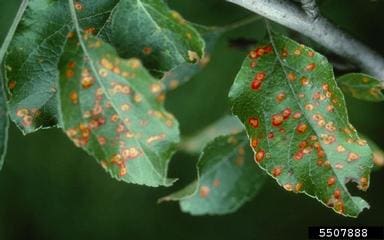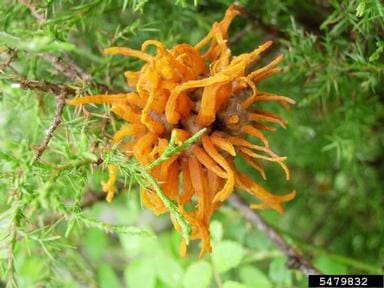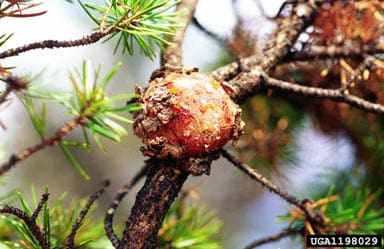Gardening enthusiasts and professional growers alike know the frustration of dealing with plant diseases. With the muggy weather we have been experiencing lately, it has been the perfect environment for fungal diseases to spread throughout your property. Among the myriad of challenges, rust diseases stand out due to their distinctive appearance and potentially devastating impact on a wide range of plants. Rusts, caused by various fungi, can turn a lush, healthy garden into a landscape dotted with unsightly rust-colored pustules.
In this blog, we’ll delve into the world of plant rusts, exploring what they are, the common types that may affect your plants, and how to identify, prevent, and treat them effectively. Whether you’re a home gardener concerned about your roses or a farmer worried about your crops, our comprehensive guide will equip you with the knowledge to combat these persistent fungal foes. Let’s dive in and learn how to keep your plants rust-free and thriving!
What is Rust on Plants?
Rust on plants is a common fungal disease that affects a wide range of plant species. This disease is characterized by its distinctive orange, yellow, or brown pustules that form on the leaves, stems, and fruits of infected plants. These rust-colored spots are masses of spores produced by the rust fungi, which can significantly impact the health and appearance of the plants.
Common Types of Plant Rust Diseases
There are many types of rust diseases, each affecting different plant species. Some of the most common types include:
- Cedar Apple Rust: Affects apples, crabapples, and eastern red cedar trees.
- White Pine Blister Rust: A serious disease for five-needle pines, especially the white pine.
- Cedar Quince Rust: Has the broadest host range, affecting many genera in the rose family. Targets roses, leading to yellow spots on leaves.
- Soybean Rust: Affects soybean crops, causing significant agricultural losses.
Species Susceptible to Rusts:
- Cedar
- Apple/Crab Apple
- Pears
- Quince
- Hawthorn
- Serviceberry
- Photinia
- Gooseberry
- White Pines
- Roses
Frequently Asked Questions About Plant Rusts
Can Rust Disease Kill Plants?
Rusts can severely weaken plants, reducing their vigor and productivity. While it may not directly kill mature plants, severe or repeated infections can cause significant damage, leading to stunted growth, premature leaf drop, and reduced yields in fruiting plants. In young or particularly vulnerable plants, rust can be fatal if not managed properly.
Are Rust Diseases Contagious to Other Plants?
Yes, rust diseases are highly contagious and can spread rapidly between susceptible plants. Rust fungi produce spores that are carried by wind, water, insects, or even gardening tools. These spores can infect other plants, especially if the environmental conditions are favorable for fungal growth, such as high humidity and moderate temperatures.
Identifying Rust Infections
Signs and Symptoms of Rust on Plants
The most recognizable signs of rust infections are the rust-colored pustules on the undersides of leaves. Other symptoms include:
- Yellow, brownish-orange, or white spots on the upper leaf surfaces.
- Premature leaf drop.
- Stunted growth and deformities in severe cases.
- Thin, weak stems in severely affected plants.
How to Identify Cedar Apple Rust
Cedar apple rust has a unique life cycle involving both apple (or crabapple) trees and eastern red cedar trees. On apple trees, it causes yellow-orange spots on leaves and fruits.
Pictured: Rust spots on leaves of apple tree.
George Hudler, Cornell University, Bugwood.org

On cedar trees, it forms large, gelatinous orange galls. Identifying these distinctive symptoms on both host plants can help confirm the presence of cedar apple rust.
Pictured: Gelatinous tendrils on an infected cedar tree.
Elizabeth Bush, Virginia Polytechnic Institute and State University, Bugwood.org

Prevention and Control of Rust Diseases
Though some rusts can complete their life cycle on just one host plant, many rusts require two different species in order to develop. This is why many rusts are named after the two species needed for them to grow and spread, such as “Cedar-apple rust”.
Preventive Measures Against Rust Infections
- Select Resistant Varieties: Choose plant varieties that are resistant to rust diseases. Or varieties that when coupled do not create the habitat for rust to develop.
- Proper Spacing: If you are going to have two host species on your property, ensure they are very far apart from one another so that rain or wind cannot carry the spores from one susceptible tree to the other.
- Pruning: Regularly pruning your trees will increase airflow throughout the canopy to reduce humidity.
RTEC’s Effective Treatments for Rust Diseases
- Intensive Treatments: Our carefully crafted regime of fungicide treatments can protect plants from rust infections.
- Pruning: Once a tree becomes infected, it is important to have the infected areas cleaned out by a professional to avoid accidentally spreading the fungi to other parts of the tree.
- Sanitation: Remove and destroy infected plant material to prevent the spread of spores.
- Plant Healthcare Inspections: If you are a valued member of a Plus or Premier level of our Canopy Protection Program, our plant healthcare technicians can monitor and treat ornamental plants for fungal diseases.
Our integrated approach of combining chemical treatments with mechanical practices like pruning is the most effective way to manage rust diseases.
Our Team Can Help You Prevent and Manage Rust Diseases
At RTEC Treecare, our expert team is here to help you keep your plants healthy and free from rust diseases. We offer comprehensive plant healthcare services, including disease prevention and treatment plans tailored to your specific needs. Whether you’re dealing with cedar apple rust or any other type of rust disease, we have the knowledge and experience to protect your plants.
Rust diseases can be a serious threat to your garden, but with the right knowledge and preventive measures, you can keep your plants healthy and vibrant. Regular monitoring, proper cultural practices, and timely treatments are key to managing rust infections effectively.

